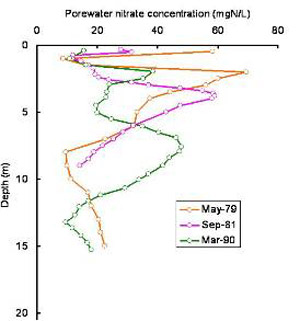Nitrate contamination in groundwater

Nitrate contamination of groundwater has long been recognised as an important public health issue.
Sources of nitrate in groundwater
The majority of nitrate in groundwater in the UK is derived from diffuse pollution from agriculture, with the rest from sewage sludge disposal to land, atmospheric deposition and point sources.
The loading has significantly increased due to post-1945 agricultural intensification due both to ploughing of grassland and to increased fertiliser applications.
Nitrate moves slowly through the unsaturated zone
Pioneering work was done in the 1970s to understand how different UK land-use practices affected nitrate leaching to groundwater and how nitrate moves through the unsaturated zone of the major aquifers.
The BGS used cored boreholes to obtain profiles of the unsaturated zone pore water nitrate concentration as a function of depth.
Sequential profiles as shown in Figure 1 can be used to estimate unsaturated zone travel time. BGS holds a nitrate profiles database containing over 350 nitrate profiles.
This research showed that downward movement of nitrate stored in the aquifer matrix to the water table was only about 0.7–2 m per year for the major aquifers of the Chalk and Permo-Triassic sandstone.
Where the unsaturated zone is thick, this stored nitrate will continue to arrive at the water table for many years to come: we call this the nitrate 'time bomb' or nitrate peaks. BGS has recently quantified the amount of nitrate stored in the unsaturated zone globally for the first time.
This delay has implications for groundwater management and meeting the requirements of the Water Framework Directive. The Eden Valley project has been exploring these issues.
Historical nitrate inputs are causing today's rising concentrations in groundwater
Groundwater nitrate concentrations in some locations are now high and are often approaching, or have already exceeded, statutory limits for drinking water.
Trends in nitrate concentrations in UK groundwater are rising at an average 0.3 mg/l/year.
Nitrate fluctuations in groundwater at many sites show seasonal variation with highest concentrations during the winter and spring, corresponding to high water levels.
Climate change is likely to affect nitrate leaching to groundwater.
Key historical publications
Foster, S S D, and Crease, R I. 1974. Nitrate pollution of Chalk groundwater in East Yorkshire — a hydrogeological appraisal. Journal of the Institute of Water Engineers 28: 178–194.
Foster, S S D, and Young, C P. 1980. Groundwater contamination due to agricultural land-use practices in the United Kingdom. In Aquifer Contamination & Protection, UNESCO-IHP Studies and Reports in Hydrogeology Series, 30; 262–282.
Chilton, P J, and Foster, S S D. 1991. Control of groundwater nitrate contamination pollution by land-use change. In Nitrate Contamination: Exposure, Consequence and Control. NATC ASI Series Vol G30, Bogardi, I, Kuzelka, RD, Ennenga, WG (eds). New York, Springer-Verlag; 333–347.
Contact
Contact Dan Lapworth for further information







